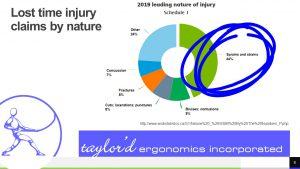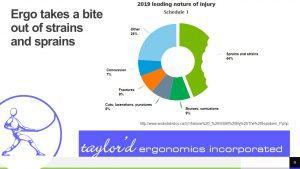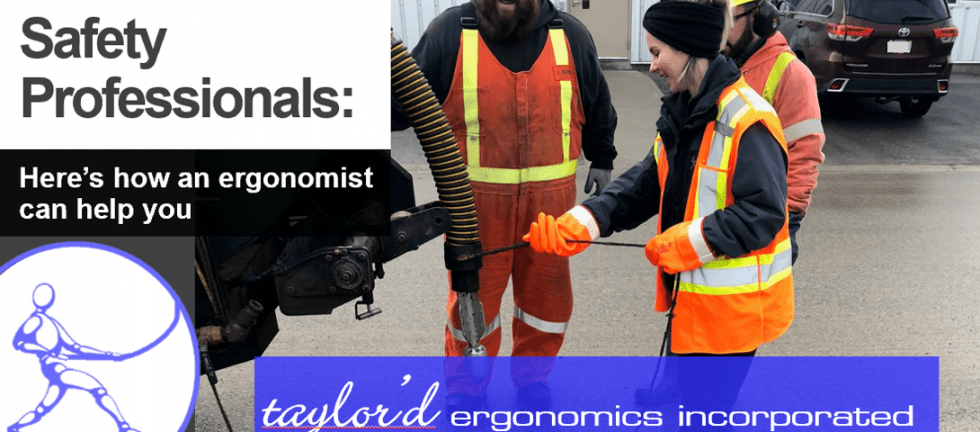Safety Professionals help organizations to reduce, or even eliminate, the risk of workplace accidents and injuries. Most safety programs rightly prioritize efforts to manage hazards that could cause serious injury or death – crushing hazards, chemical exposures, falls from heights, and confined space, as a few examples. Logically, most Safety Managers spend the better part of the day ensuring compliance with legislation. Since Covid hit, I’d wager that even less time can be spared to think about strain/sprain injury hazards. (Thankfully, we are still busy – here’s a shout out to the clients who have continued to invest in ergonomics!)

However, when we look at the injuries that occur in the workplace, the majority of claims, almost half of them, relate to strain/sprain injuries. And Covid hasn’t helped – covid barriers and workplace practices have made some jobs more awkward and repetitive.
Even Safety Professionals who have an ergonomics background are challenged to find the time to dig for solutions for strain/sprain hazards. Why is that? Aside from the obvious time demands associated with the management of designated substances, lockout-tagout, heat stress prevention, and myriad other safety programs, ergonomics requires a singular focus. You can walk by a strain/sprain injury hazard every day without acknowledging it, because it is part of the landscape – the way things have always been done. It’s very difficult, as an insider, to “see” these hazards, although you may “look” at them every day. Even when injuries are reported, it’s difficult to recognize the hazards. Faced with the immediate requirement to identify a cause and a corrective action, injury reports often attribute the strain/sprain injuries to predispositions (the employee was overly tired from a weekend reno project), work technique (she didn’t lift correctly), or inexperience (he was new to the job).
A full ergonomics assessment involves taking measurements so the hazard can be prioritized using assessment tools. Unlike noise, heat, or chemical exposure assessments, this is not done with a single “meter” or device. The ergonomist observes the job, interacts with the workers, measures forces (efforts), and quantifies the frequency and duration of exposure. The ergonomist chooses and uses the appropriate analysis tool for the job – often a biomechanical model that is complex even for us. Understandably, few Safety Professionals have the time or equipment needed to complete these assessments. An ergonomist has the resources and time to focus on the hazards, and help an organization to understand what needs to change, and why.
If an assessment shows that a job requires engineering controls, an ergonomist can work with the company’s resources (engineering, maintenance, supervisors, and purchasing, for example) to implement these types of changes. Having an ergonomist available can take a huge strain away from the Safety Manager!
Sometimes, an assessment will show that employee coaching or training is warranted. An ergonomist can develop and facilitate training to explain, demonstrate, and encourage the practice of safer work methods for specific tasks. We can even coach employees in the workplace, just as a coach would support an athlete.
A good ergonomist is visible in the facility and builds relationships with many different employees in an organization (from the front-line to managers, and maintenance to purchasing). Because ergonomists must understand the worker’s perspective to assess a hazard, we tend to enhance a safety program by building bridges between workers and management.
If you, like many organizations, struggle to invest time into reducing strain/sprain injury hazards, give an ergonomist a chance to tackle them. You won’t be disappointed. We asked some of our clients if having an ergonomist available helped them, and this is what they told us:
“Having an on-site resource is a welcome support for an HSE professional….from completing an office assessment, to reviewing a challenging repetitive motion task. There are many ways to view corrective actions; an ergonomist’s eye brings a great deal of value.”
Jenanne Graham, Jones Healthcare Group
“Taylor’d Ergonomics helps keep a safe work environment for all our employees. It keeps our employees engaged. Employees see that the company is putting forth their best efforts to ensure their health and safety, which increases employee morale.”
Adient Seating Canada LP

If you’re a safety professional and you’re wondering how you’ll ever take a bite out of the strain/sprain piece of the pie chart, give us a call. We have the resources to help!
(And I remind you once again that we are especially poised to start helping you in July or August, with our OSE+ program. Contact Carrie for info on this incredibly well-priced, “Taylor’d” program!)


